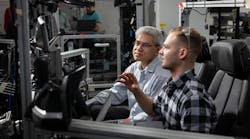GM’s Approach: Innovate Collaboratively, Integrate Tech Uniquely
New technology, changes in consumer preferences and an increased urgency around sustainability are propelling automotive manufacturing into a new period of innovation. The advancement of artificial intelligence (AI) is paving the way for autonomous, electric and low-emission vehicles, which in turn promise a safe and sustainable future.
But AI has applications throughout the manufacturing process–from vehicle design and testing to using computer vision systems to identify and resolve faults. With new products and materials emerging daily, manufacturers that are not continuously improving on processes, equipment and operations could quickly be left behind.
Increasing the Pace
As researchers in the automotive manufacturing space, our charge is to innovate continuously. To do that, we need to streamline the innovation process, removing unnecessary steps and eliminating roadblocks. At General Motors, we achieve this through an open innovation model. Open innovation describes the process of combining technology from inside and outside of the company to create new applications.
By removing the need to create technology from scratch, we can focus efforts on applying and integrating the technology in unique ways, streamlining the research and development process while maximizing results. For example, one team within GM is working to create reconfigurable assembly systems using advanced, off-the-shelf technology such as vision systems, robotics and reconfigurable tooling. By combining existing technologies in a model that caters specifically to our needs, we can build configurable, scalable manufacturing systems, ultimately eliminating hard fixtures in our plants.
As applied researchers, our role is to understand problems inside the company and use new and existing concepts to propose solutions. Tapping into outside technology is one way to accelerate this process. Another critical ingredient is early-stage research, which primarily takes place outside of our walls in national labs, universities and research-oriented organizations. By collaborating with these institutions, we can move early-stage research toward applied development.
Inspiring Collaboration
Today, one of our industry's most significant challenges is realizing the promise of smart manufacturing. Theoretically, smart manufacturing allows for fully integrated collaborative manufacturing systems that use data to respond in real-time to meet changing conditions–from supply chain issues to shifts in customer demand.
But the data sets that inform smart manufacturing systems are large and complex. To build adaptable, resilient systems, we need to understand how to translate raw data into actionable information and apply that information to our work. Early-stage research has a vital role to play.
This week, academics in engineering and professionals in the manufacturing research space are coming together to attend the 50th Annual North American Manufacturing Research Conference (NAMRC) at Purdue University. The longest-running forum for applied research and industrial applications in manufacturing and design, the five-day event will feature presentations and publications of original, basic and applied research. Topics will range from big data analytics applications for manufacturing planning and control to challenges and opportunities in additive manufacturing.
For industry professionals, forums like NAMRC provide an invaluable opportunity to influence academic research and inspire a deeper focus on priority areas. For example, GM began working in ultrasonic welding about 10 years ago. At the time, one challenge we encountered was the lack of scientific literature on the topic. By sharing our work at conferences, we were able to stimulate focus and discourse around it, inspiring a slew of academic papers and early-stage research that continues to this day.
Innovating for the Future
Today, we use deep learning and convolutional (visual-based) neural networks in the vision systems that monitor quality in our assembly lines. These trace their roots back to the early 1970s, when researchers began exploring the possibility of neural networks. In the intervening decades, research and development professionals in the automotive space have been working continuously to model applications for this technology in manufacturing.
In neural networks, we see AI's true potential to innovate not just within our products but also in our processes and operations. The use of data for process and operational improvement will be a catalyst behind most of our industry's significant goals over the next decade, from electrification and sustainability to self-driving vehicles. But to get there, we need more efficient ways of sorting our datasets and transforming big data into tailored, usable information. That requires in-depth, early-stage and applied research–and we have significant opportunity for growth.
To realize the potential of smart manufacturing, we will need significant research focus on areas like data in manufacturing, manufacturing robustness and the use of simulation for discovery. By sharing our work with the academic community at summits like NAMRC, we have the opportunity to drive the research that, in the future, will be recognized as the bedrock for innovations we cannot yet even envisage.
Dr. Jeffrey Abell is chief scientist for global manufacturing and director of manufacturing systems research at General Motors. He is responsible for global manufacturing research focused on vehicle electrification, lightweight systems manufacturing, automation and smart manufacturing. He led a research team that played a key role in bringing the Chevy Volt advanced battery to production and has held other leadership positions in product development and manufacturing at GM, Delphi, and DaimlerChrysler.




